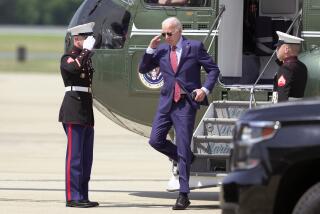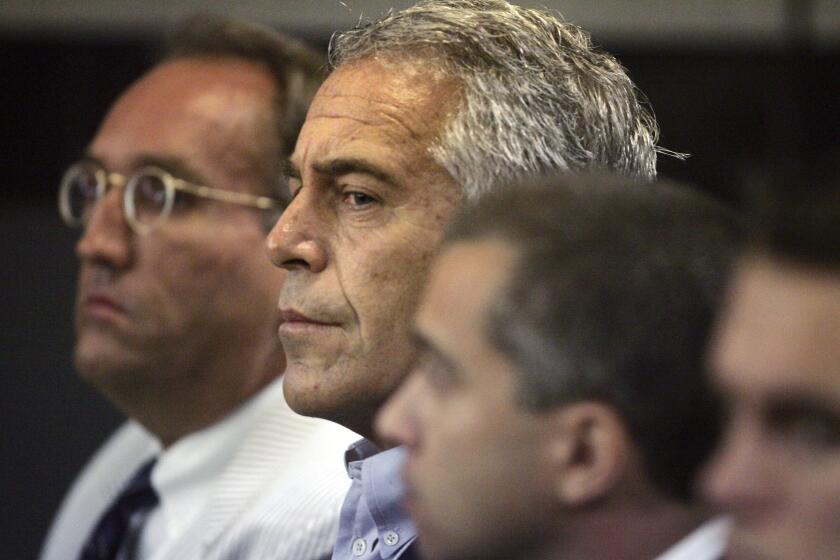Hussein Pulls Warplanes Out of Shiite Region
- Share via
WASHINGTON — Anticipating a U.S. announcement of a “no-fly” zone over southern Iraq, President Saddam Hussein has ordered the rapid withdrawal of all fixed-wing Iraqi warplanes deployed below the 32nd Parallel in his country, Administration sources said Monday.
The operation, launched over the weekend, coincided with military attacks by both Iraqi ground troops and helicopter gunships against Shiite Muslim rebel positions in the southern marshlands, the sources said.
The military assault continued into Monday, when Hussein also dispatched three ranking Cabinet ministers to southern Iraq to drum up support from Shiite leaders, and when his media went on a verbal offensive against the U.S.-led coalition.
“The marshlands will be a graveyard for enemies and invaders,” the Defense Ministry newspaper Al Qadissiyah pronounced in a headline Monday.
The Iraqi moves, all reminiscent of the run-up to Operation Desert Storm, offered the first indication that Baghdad now believes that a showdown is unavoidable and is taking steps to prepare for it.
The Iraqi press quoted Hussein on Monday as promising “no compromise of national rights” in the confrontation with the West.
“Iraqis will surely emerge victorious from the present confrontation with their enemies,” he was quoted as saying at an emergency weekend Cabinet meeting.
After weeks of bold bluffs, the redeployment of warplanes and the public relations campaigns indicate nervousness in Hussein’s inner circle, the sources said.
Before last year’s Persian Gulf War, Iraq sent many of its air force’s best fighters and bombers to Iran, where they remain.
Hussein also pledged victory against the U.S.-dominated military coalition in what he predicted would be “the mother of all battles.”
President Bush is expected to announce today that the United States, France and Britain will use air power to force Hussein to comply with U.N. resolutions that followed the end of the Gulf War and to shoot down any Iraqi planes flying below the 32nd Parallel. The U.N. resolutions bar Hussein from suppressing the Iraqi population and give international inspectors the right to find and dispose of weapons of mass destruction.
The no-fly zone would cover roughly the southern third of Iraq, including vast marshlands sheltering Shiite Muslims who fled after Hussein’s forces crushed their revolt in the wake of the Gulf War.
Administration sources said that the zone is expected to go into effect within 24 hours of the announcement.
On Monday, the allies worked to sort out minor logistic issues, including British and French access to Persian Gulf air bases, and sources denied reports of a delay because of Arab opposition.
“We have been briefing all interested parties, and no one we are aware of has said they are opposed to this, specifically Egypt and Syria,” an Administration source said.
Both Egypt and Syria sent troops to the area for Operation Desert Storm, and their support, tacit or declared, is considered vital to the international credibility of the U.S.-dominated coalition. The source noted, however, that “briefings are different from signing on. There’s no need to say yes or no.”
Kuwait is the only Arab country so far to publicly support the no-fly zone, although most of those countries favor action to prevent Hussein from strengthening his position.
Several Arab states both in and outside the coalition are known to be anxious about the possibility that a sequel to Desert Storm would result in the formal or de facto partitioning of Iraq into separate Kurdish and Shiite zones. They also are concerned about the possibility that other oil-rich Persian Gulf states would be destabilized.
Administration officials and the Shiite opposition have been trying to assure Arab leaders that no one wants to see the country break up into three mini-states.
Meanwhile, Hussein’s Defense Minister, Ali Hassan Majid, toured the region south of the 32nd Parallel and met tribal leaders who pledged to “sacrifice our souls in defense of our country’s sovereignty and security,” according to a report in Al Qadissiyah.
On the eve of what increasingly appears to be a confrontation, U.S. military officials said that the coalition is now prepared to initiate the operation with the forces already in place.
A few “odds and ends” are still scheduled to fly to the region to bolster the task force now there, but none are necessary to enforce the no-fly zone, a senior Pentagon official said.
U.S. military officials will be surprised if Hussein challenges the exclusion zone, he added. “He either will show some sense or his pilots won’t carry out his orders,” the official said. “They haven’t been training, they have shortages of equipment and spare parts, and his best planes are in Iran.”
Times staff writer John Broder contributed to this report.
More to Read
Sign up for Essential California
The most important California stories and recommendations in your inbox every morning.
You may occasionally receive promotional content from the Los Angeles Times.













